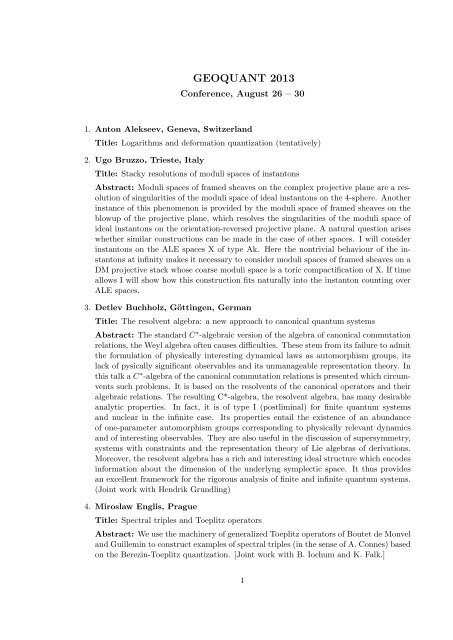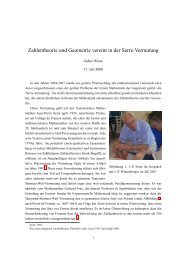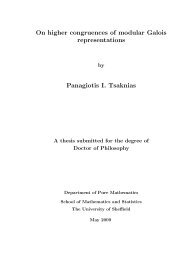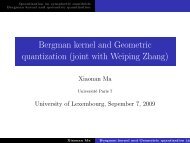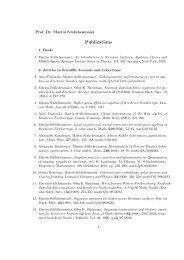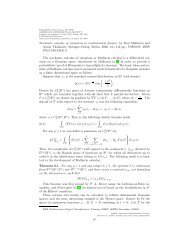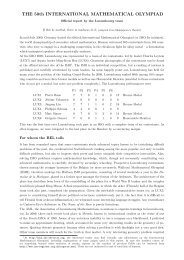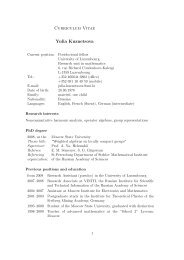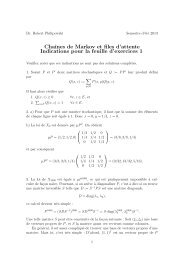Talks on the Conference Geoquant 2013, ESI - Mathematics ...
Talks on the Conference Geoquant 2013, ESI - Mathematics ...
Talks on the Conference Geoquant 2013, ESI - Mathematics ...
Create successful ePaper yourself
Turn your PDF publications into a flip-book with our unique Google optimized e-Paper software.
GEOQUANT <strong>2013</strong><br />
C<strong>on</strong>ference, August 26 – 30<br />
1. Ant<strong>on</strong> Alekseev, Geneva, Switzerland<br />
Title: Logarithms and deformati<strong>on</strong> quantizati<strong>on</strong> (tentatively)<br />
2. Ugo Bruzzo, Trieste, Italy<br />
Title: Stacky resoluti<strong>on</strong>s of moduli spaces of instant<strong>on</strong>s<br />
Abstract: Moduli spaces of framed sheaves <strong>on</strong> <strong>the</strong> complex projective plane are a resoluti<strong>on</strong><br />
of singularities of <strong>the</strong> moduli space of ideal instant<strong>on</strong>s <strong>on</strong> <strong>the</strong> 4-sphere. Ano<strong>the</strong>r<br />
instance of this phenomen<strong>on</strong> is provided by <strong>the</strong> moduli space of framed sheaves <strong>on</strong> <strong>the</strong><br />
blowup of <strong>the</strong> projective plane, which resolves <strong>the</strong> singularities of <strong>the</strong> moduli space of<br />
ideal instant<strong>on</strong>s <strong>on</strong> <strong>the</strong> orientati<strong>on</strong>-reversed projective plane. A natural questi<strong>on</strong> arises<br />
whe<strong>the</strong>r similar c<strong>on</strong>structi<strong>on</strong>s can be made in <strong>the</strong> case of o<strong>the</strong>r spaces. I will c<strong>on</strong>sider<br />
instant<strong>on</strong>s <strong>on</strong> <strong>the</strong> ALE spaces X of type Ak. Here <strong>the</strong> n<strong>on</strong>trivial behaviour of <strong>the</strong> instant<strong>on</strong>s<br />
at infinity makes it necessary to c<strong>on</strong>sider moduli spaces of framed sheaves <strong>on</strong> a<br />
DM projective stack whose coarse moduli space is a toric compactificati<strong>on</strong> of X. If time<br />
allows I will show how this c<strong>on</strong>structi<strong>on</strong> fits naturally into <strong>the</strong> instant<strong>on</strong> counting over<br />
ALE spaces.<br />
3. Detlev Buchholz, Göttingen, German<br />
Title: The resolvent algebra: a new approach to can<strong>on</strong>ical quantum systems<br />
Abstract: The standard C ∗ -algebraic versi<strong>on</strong> of <strong>the</strong> algebra of can<strong>on</strong>ical commutati<strong>on</strong><br />
relati<strong>on</strong>s, <strong>the</strong> Weyl algebra often causes difficulties. These stem from its failure to admit<br />
<strong>the</strong> formulati<strong>on</strong> of physically interesting dynamical laws as automorphism groups, its<br />
lack of pysically significant observables and its unmanageable representati<strong>on</strong> <strong>the</strong>ory. In<br />
this talk a C ∗ -algebra of <strong>the</strong> can<strong>on</strong>ical commutati<strong>on</strong> relati<strong>on</strong>s is presented which circumvents<br />
such problems. It is based <strong>on</strong> <strong>the</strong> resolvents of <strong>the</strong> can<strong>on</strong>ical operators and <strong>the</strong>ir<br />
algebraic relati<strong>on</strong>s. The resulting C*-algebra, <strong>the</strong> resolvent algebra, has many desirable<br />
analytic properties. In fact, it is of type I (postliminal) for finite quantum systems<br />
and nuclear in <strong>the</strong> infinite case. Its properties entail <strong>the</strong> existence of an abundance<br />
of <strong>on</strong>e-parameter automorphism groups corresp<strong>on</strong>ding to physically relevant dynamics<br />
and of interesting observables. They are also useful in <strong>the</strong> discussi<strong>on</strong> of supersymmetry,<br />
systems with c<strong>on</strong>straints and <strong>the</strong> representati<strong>on</strong> <strong>the</strong>ory of Lie algebras of derivati<strong>on</strong>s.<br />
Moreover, <strong>the</strong> resolvent algebra has a rich and interesting ideal structure which encodes<br />
informati<strong>on</strong> about <strong>the</strong> dimensi<strong>on</strong> of <strong>the</strong> underlyng symplectic space. It thus provides<br />
an excellent framework for <strong>the</strong> rigorous analysis of finite and infinite quantum systems.<br />
(Joint work with Hendrik Grundling)<br />
4. Miroslaw Englis, Prague<br />
Title: Spectral triples and Toeplitz operators<br />
Abstract: We use <strong>the</strong> machinery of generalized Toeplitz operators of Boutet de M<strong>on</strong>vel<br />
and Guillemin to c<strong>on</strong>struct examples of spectral triples (in <strong>the</strong> sense of A. C<strong>on</strong>nes) based<br />
<strong>on</strong> <strong>the</strong> Berezin-Toeplitz quantizati<strong>on</strong>. [Joint work with B. Iochum and K. Falk.]<br />
1
5. Jürgen Fuchs Karlstad, Sweden<br />
Title: Three-dimensi<strong>on</strong>al topological field <strong>the</strong>ories <strong>on</strong> manifolds with boundaries and<br />
defects<br />
Abstract: We describe a bicategorical framework for topological boundary c<strong>on</strong>diti<strong>on</strong>s<br />
and topological surface defects in three-dimensi<strong>on</strong>al topological field <strong>the</strong>ories of<br />
Reshetikhin-Turaev type. Relevant tools include modules over tensor categories, <strong>the</strong><br />
noti<strong>on</strong> of center of a fusi<strong>on</strong> category, central functors and <strong>the</strong> Witt group of modular<br />
tensor categories. We also outline potential applicati<strong>on</strong>s to two-dimensi<strong>on</strong>al rati<strong>on</strong>al<br />
c<strong>on</strong>formal field <strong>the</strong>ories.<br />
6. Hajimi Fujita, Tokyo, Japan<br />
Title: Equivariant local index and transverse index for circle acti<strong>on</strong><br />
Abstract: In our joint work with Furuta and Yoshida we gave a formulati<strong>on</strong> of index<br />
<strong>the</strong>ory of Dirac-type operator <strong>on</strong> open Riemannian manifolds. We used a torus fibrati<strong>on</strong><br />
and a perturbati<strong>on</strong> by Dirac-type operator al<strong>on</strong>g fibers. In this talk we develop an<br />
equivariant versi<strong>on</strong> for circle acti<strong>on</strong> and apply it for Hamilt<strong>on</strong>ian circle acti<strong>on</strong> case.<br />
We also investigate <strong>the</strong> relati<strong>on</strong> between our equivariant index and index of transverse<br />
elliptic operator/symbol developed by Atiyah, Paradan-Vergne and Braverman.<br />
7. Tomohiro Fukaya, Sendai, Japan<br />
Title: The coarse Baum-C<strong>on</strong>nes c<strong>on</strong>jecture for relatively hyperbolic groups<br />
Abstract: We study a group which is hyperbolic relative to a finite family of infinite<br />
subgroups. We show that <strong>the</strong> group satisfies <strong>the</strong> coarse Baum-C<strong>on</strong>nes c<strong>on</strong>jecture if each<br />
subgroup bel<strong>on</strong>ging to <strong>the</strong> family satisfies <strong>the</strong> coarse Baum-C<strong>on</strong>nes c<strong>on</strong>jecture and its<br />
classifying space is realized by a finite simplicial complex. We also c<strong>on</strong>struct a boundary<br />
of relatively hyperbolic group and show that its K-homology is isomorphic to <strong>the</strong> K-<br />
<strong>the</strong>ory of <strong>the</strong> Roe algebra of <strong>the</strong> group under suitable assumpti<strong>on</strong>s. We give an explicit<br />
computati<strong>on</strong> for <strong>the</strong> case of a n<strong>on</strong>-uniform lattice of rank <strong>on</strong>e symmetric space. This<br />
talk is based <strong>on</strong> <strong>the</strong> joint work with Shin-ichi Oguni.<br />
8. Alexey Gorodentsev, Moscow, Russia<br />
Title: Mukai Lattices<br />
Abstract: Mukai lattice is a free Z-module M equipped with unimodular (maybe<br />
ne<strong>the</strong>r symmetric nor skew symmetric) integer bilinear form. Mukai lattices that admit<br />
excepti<strong>on</strong>al basis (i.e. a basis whose Gram matrix is upper triangular with units <strong>on</strong> <strong>the</strong><br />
main diag<strong>on</strong>al) play especially important role. They appear in <strong>the</strong> algebraic geometry as<br />
K 0 -groups of Fano varieties having excepti<strong>on</strong>al basis in <strong>the</strong> derived category. They appear<br />
in <strong>the</strong> <strong>the</strong>ory of singularities as vanishing cohomologies equipped with distinguished<br />
basis and <strong>the</strong> Seifert form. They appear in c<strong>on</strong>necti<strong>on</strong> with quantum cohomologies and<br />
Frobenius manifolds as <strong>the</strong> Stokes matrices of semisimple Frobenius manifolds. There<br />
is a number of c<strong>on</strong>jectures explaining <strong>the</strong> reas<strong>on</strong>s for this phenomen<strong>on</strong> and linking <strong>the</strong><br />
corresp<strong>on</strong>ding ma<strong>the</strong>matical areas.<br />
We will discuss <strong>the</strong>se links, <strong>the</strong>se c<strong>on</strong>jectures, old and new results obtained here, as well<br />
as (ra<strong>the</strong>r mysterious) c<strong>on</strong>necti<strong>on</strong> of Mukai lattices with classical problems of <strong>the</strong> <strong>the</strong>ory<br />
of Diophantine approximati<strong>on</strong>s:<br />
2
It is known that <strong>the</strong> Mukai lattice K 0 (P 2 ), of <strong>the</strong> projective plane, is closely c<strong>on</strong>nected<br />
with <strong>the</strong> Markov chain of homogeneous quadratic forms f m (x, y) ∈ Z[x, y] of positive<br />
discriminant D m > 0 such that min (x,y)∈Z\0<br />
(f(x, y)/ √ )<br />
(D) reach his absolute maximum<br />
am<strong>on</strong>g all <strong>the</strong> forms f at SL 2 (Z)-orbit of f = f 1 , <strong>the</strong>n reach his absolute maximum<br />
am<strong>on</strong>g all <strong>the</strong> remaining forms f at SL 2 (Z)-orbit of f = f 2 , e.t.c. Namely, <strong>the</strong> Markov<br />
forms appear as restricti<strong>on</strong>s of (<strong>the</strong> symmetric part of) <strong>the</strong> Mukai form <strong>on</strong> K 0 (P 2 ) = Z 3<br />
to <strong>the</strong> ortog<strong>on</strong>al planes to excepti<strong>on</strong>al vectors (i.e. <strong>the</strong> vectors that can be included into<br />
some excepti<strong>on</strong>al basis). Has this story a c<strong>on</strong>tinuati<strong>on</strong> to totally real cubic forms and<br />
K 0 (P 3 )? Here even <strong>the</strong> whole chain of forms is unknown, <strong>on</strong>ly <strong>the</strong> first 2 forms were<br />
found by Davenport. . .<br />
9. Brian Hall, Notre Dame, USA<br />
Title: The large-N limit of <strong>the</strong> Segal-Bargmann transform <strong>on</strong> unitary groups<br />
Abstract: I will describe recent results <strong>on</strong> <strong>the</strong> large-N limit of <strong>the</strong> Segal-Bargmann<br />
transform <strong>on</strong> <strong>the</strong> unitary group U(N). In <strong>the</strong> large-N limit, <strong>the</strong> heat kernel measure <strong>on</strong><br />
U(N) c<strong>on</strong>centrates <strong>on</strong>to a single c<strong>on</strong>jugacy class. Thus, <strong>the</strong> transform <strong>on</strong> class functi<strong>on</strong>s<br />
becomes trivial in <strong>the</strong> limit. One can, however, extend <strong>the</strong> transform to matrix-valued<br />
functi<strong>on</strong>s and study functi<strong>on</strong>s that are equivariant under c<strong>on</strong>jugati<strong>on</strong>. In <strong>the</strong> limit,<br />
such functi<strong>on</strong>s c<strong>on</strong>centrate to polynomials in a single U(N) variable. Thus, <strong>the</strong> limiting<br />
transform can be understood as a map of polynomials to polynomials, which we can<br />
compute explicitly. This is joint work with Bruce Driver and Todd Kemp of UCSD<br />
and is motivated by earlier work of Philippe Biane. Related results were obtained<br />
independently by Guillaume Cbr<strong>on</strong>.<br />
10. Alexander Karabegov, Abilene, USA<br />
Title: On Gammelgaards formula for a star product with separati<strong>on</strong> of variables<br />
Abstract: We show that Gammelgaards explicit formula expressing a general star<br />
product with separati<strong>on</strong> of variables <strong>on</strong> a Kaehler manifold in terms of directed acyclic<br />
graphs is equivalent to an inversi<strong>on</strong> formula for an operator <strong>on</strong> a formal Fock space.<br />
We c<strong>on</strong>struct an algebra of operators c<strong>on</strong>taining this operator and its inverse. The<br />
operators in this algebra are expressed in terms of directed acyclic graphs. We give a<br />
compositi<strong>on</strong> formula for this algebra and <strong>the</strong>n prove <strong>the</strong> inversi<strong>on</strong> formula directly, thus<br />
offering an alternative proof of Gammelgaards formula which offers more insight into<br />
<strong>the</strong> questi<strong>on</strong> why <strong>the</strong> directed graphs in his formula have no cycles. Also, an explicit<br />
invariant formula for a star product with separati<strong>on</strong> of variables can be easily deduced<br />
from Gammelgaard’s formula.<br />
11. Will Kirwin, Cologne, Germany<br />
Title: Complex-time evoluti<strong>on</strong> in geometric quantizati<strong>on</strong><br />
Abstract: Using ideas of Thiemann, <strong>the</strong> adapted complex structure <strong>on</strong> a tubular neighborhood<br />
of a compact real-analytic Riemannian manifold in its tangent bundle can be<br />
interpreted as <strong>the</strong> “time-i” geodesic flow. On <strong>the</strong> tangent bundle of a compact Lie group,<br />
<strong>the</strong> compositi<strong>on</strong> of <strong>the</strong> geometric quantizait<strong>on</strong> of this imaginary-time geodesic flow with<br />
<strong>the</strong> Schroedinger quantizati<strong>on</strong> of <strong>the</strong> associated hamilt<strong>on</strong>ian yields Hall’s coherent state<br />
transform (CST). In this talk, I will explain <strong>the</strong>se ideas, and how <strong>the</strong>y can be gener-<br />
3
alized to yield an infinite-dimensi<strong>on</strong>al family of “complex-time” flows and associated<br />
generalized CSTs.<br />
12. Ryoichi Kobayashi, Nagoya, Japan<br />
Title: Hamilt<strong>on</strong>ian Volume Minimizing Property of Maximal Torus Orbits in Complex<br />
Projective Spaces<br />
Abstract: We prove that any U(1) n -orbit in P n is Hamilt<strong>on</strong>ian volume minimizing,<br />
i.e., volume minimizing under Hamilt<strong>on</strong>ian deformati<strong>on</strong>. The idea is <strong>the</strong> following :<br />
(1) We extend <strong>on</strong>e U(1) n -orbit to <strong>the</strong> moment torus fibrati<strong>on</strong> {T t } t∈∆n and c<strong>on</strong>sider its<br />
Hamilt<strong>on</strong>ian defoemati<strong>on</strong> {φ(T t )} t∈∆n where φ is a Hamilt<strong>on</strong>ian diffeomorphism of P n<br />
and <strong>the</strong>n :<br />
(2) We c<strong>on</strong>sider each U(1) n -orbit and its Hamilt<strong>on</strong>ian deformati<strong>on</strong> by comparing <strong>the</strong><br />
large k asymptotic behavior of <strong>the</strong> sequence of projective embeddings defined, for each<br />
k, by <strong>the</strong> basis of H 0 (P n , O(k)) obtained by semi-classical approximati<strong>on</strong> of <strong>the</strong> O(k)-BS<br />
(Bohr-Sommerfeld) tori of <strong>the</strong> Lagrangian torus fibrati<strong>on</strong> {T t } t∈∆n and its Hamilt<strong>on</strong>ian<br />
deformati<strong>on</strong> {φ(T t )} t∈∆n .<br />
13. Gandalf Lechner, Leipzig, Germany<br />
Title: N<strong>on</strong>-local perturbati<strong>on</strong>s of hyperbolic PDEs and QFT models <strong>on</strong> n<strong>on</strong>-commutative<br />
spacetimes<br />
Abstract: In <strong>the</strong> c<strong>on</strong>text of formulating quantum field <strong>the</strong>ories over n<strong>on</strong>-commutative<br />
spacetimes, such as Moyal Minkowski space or locally n<strong>on</strong>-commutative versi<strong>on</strong>s <strong>the</strong>reof,<br />
<strong>on</strong>e is led to c<strong>on</strong>sider a class of partial differential equati<strong>on</strong>s of <strong>the</strong> form (D+W)f=0,<br />
where D is a normally hyperbolic differential operator or Dirac operator, and W is<br />
some n<strong>on</strong>-local perturbati<strong>on</strong> (”n<strong>on</strong>-commutative potential”). Despite <strong>the</strong> n<strong>on</strong>-locality,<br />
we c<strong>on</strong>struct advanced and retarded fundamental soluti<strong>on</strong>s for such PDEs, discuss <strong>the</strong><br />
structure of <strong>the</strong>ir soluti<strong>on</strong>s, and compute <strong>the</strong> scattering behaviour. These systems can<br />
be quantized, and a n<strong>on</strong>-commutative field <strong>the</strong>ory can be extracted by a versi<strong>on</strong> of<br />
Bogoliubov’s formula. We shall also point out <strong>the</strong> similarities and differences to o<strong>the</strong>r<br />
approaches to QFT <strong>on</strong> n<strong>on</strong>-commutative spacetimes. Joint work with Markus Borris<br />
and Rainer Verch.<br />
14. Xia<strong>on</strong>an Ma, Paris, France<br />
Title: Flat vector bundle and Toeplitz operators<br />
Abstract: The real analogue of <strong>the</strong> Dolbeault complex is <strong>the</strong> de Rham complex associated<br />
with a flat vector bundle. In this talk, we explain first <strong>the</strong> <strong>the</strong>ory of Toeplitz<br />
operators associated with a bundle positive lines, and how <strong>the</strong> Toeplitz operators in<br />
complex geometry appear naturally in <strong>the</strong> study of <strong>the</strong> asymptotic properties of cohomology<br />
or spectrum associated with a family of flat vector bundles F p . For example,<br />
a real versi<strong>on</strong> of <strong>the</strong> vanishing <strong>the</strong>orem of le Potier is established using properties of<br />
<strong>the</strong> Toeplitz operator. We can give also <strong>the</strong> asymptotic informati<strong>on</strong>s for <strong>the</strong> size of <strong>the</strong><br />
torsi<strong>on</strong> elements in <strong>the</strong> cohomology group in <strong>the</strong> ari<strong>the</strong>metic case.<br />
4
15. George Marinescu, Cologne, Germany<br />
Title: Equidistributi<strong>on</strong> of random zeros <strong>on</strong> complex manifolds<br />
Abstract: This talk is c<strong>on</strong>cerned with <strong>the</strong> almost sure c<strong>on</strong>vergence to an equilibrium<br />
distributi<strong>on</strong> of zeros of random sequences of holomorphic zero sets . For example, <strong>the</strong><br />
zeros of SU(2) polynomials studied in <strong>the</strong> physics literature tend to accumulate to a<br />
uniform distributi<strong>on</strong>, <strong>the</strong> Fubini-Study measure <strong>on</strong> <strong>the</strong> Riemann sphere. The equidistributi<strong>on</strong><br />
follows in general from <strong>the</strong> asymptotic expansi<strong>on</strong> of <strong>the</strong> Bergman kernel, which<br />
gives an expansi<strong>on</strong> of <strong>the</strong> expected values of <strong>the</strong> zero-currents. This talk is based <strong>on</strong><br />
joint work with D. Coman, T.-C. Dihn and X. Ma.<br />
16. Shin-Ichi Oguni, Matsuyama, Japan<br />
Title: On <strong>the</strong> coarse Baum-C<strong>on</strong>nes c<strong>on</strong>jecture<br />
Abstract: An assembly map encodes higher indexes of elliptic differential operators.<br />
The coarse Baum-C<strong>on</strong>nes c<strong>on</strong>jecture claims that two ”coarse homology <strong>the</strong>ories” for<br />
nice proper metric spaces are equivalent by a coarse versi<strong>on</strong> of <strong>the</strong> assembly map. The<br />
c<strong>on</strong>jecture is known to be deeply related to differential topology of closed manifolds with<br />
infinite fundamental groups. In this talk, I will explain <strong>the</strong> above and introduce some<br />
known results c<strong>on</strong>taining <strong>the</strong> case of n<strong>on</strong>-positively curved metric spaces in <strong>the</strong> sense of<br />
Busemann. This talk is based <strong>on</strong> a joint work with Tomohiro Fukaya.<br />
17. Alexey Parshin, Moscow, Russia<br />
Title: Base change and automorphic inducti<strong>on</strong> in <strong>the</strong> Langlands <strong>the</strong>ory<br />
18. Armen Sergeev, Moscow<br />
Title: Quantum calculus and n<strong>on</strong>commutative Bloch <strong>the</strong>ory<br />
19. Andrei Shafarevich, Moscow, Russia<br />
Title: Quantizati<strong>on</strong> c<strong>on</strong>diti<strong>on</strong>s <strong>on</strong> Riemann surfaces and spectral series of n<strong>on</strong>-selfadjoint<br />
operators<br />
Abstract: Spectral series of a wide class of selfadjoint quantum operators satisfy Maslov<br />
quantizati<strong>on</strong> c<strong>on</strong>diti<strong>on</strong>s <strong>on</strong> invariant Lagrangian submanifolds of <strong>the</strong> real classical phase<br />
space. According to <strong>the</strong>ses c<strong>on</strong>diti<strong>on</strong>s, integrals of <strong>the</strong> fixed 1-form over arbitrary cycle<br />
<strong>on</strong> <strong>the</strong> manifold must be integers. The selfadjointness of <strong>the</strong> operator implies that <strong>the</strong><br />
series are semiclassically close to <strong>the</strong> exact spectrum. For n<strong>on</strong>-selfadjoint operators<br />
<strong>the</strong> situati<strong>on</strong> is completely different: <strong>the</strong> phase space is complex and spectral series<br />
can lie far from <strong>the</strong> exact spectrum. We study <strong>the</strong>se problems for certain operators,<br />
appearing in hydrodynamics and magnetohydrodynamics; we show that in <strong>the</strong>se cases<br />
asymptotics of <strong>the</strong> spectrum satisfies special quantizati<strong>on</strong> c<strong>on</strong>diti<strong>on</strong>s <strong>on</strong> Riemannian<br />
surfaces - complex curves of c<strong>on</strong>stant energy; according to <strong>the</strong>se c<strong>on</strong>diti<strong>on</strong>s <strong>the</strong> integral<br />
of <strong>the</strong> fixed holomorphic 1-form over some (not arbitrary) cycle must be integer. The<br />
spectrum asymptotically c<strong>on</strong>verges to <strong>the</strong> points of a graph <strong>on</strong> <strong>the</strong> complex plane and<br />
different cycles of <strong>the</strong> surface corresp<strong>on</strong>d to different edges of this graph.<br />
5
20. Georgy Sharygin, Moscow, Russia<br />
Title: Full symmetric Toda system and Bruhat order<br />
Abstract: The talk is based <strong>on</strong> a joint paper with Yu.Chernyakov (ITEP) and A.Sorin<br />
(JINR). We c<strong>on</strong>sider <strong>the</strong> full symmetric (n<strong>on</strong>periodic) Toda chain. We show, that <strong>the</strong><br />
stable points of this system are equal to <strong>the</strong> diag<strong>on</strong>al matrices with same eigenvalues,<br />
written in different order. We also show that two such matrices are c<strong>on</strong>nected by a<br />
trajectory, iff <strong>the</strong> corresp<strong>on</strong>ding permutati<strong>on</strong>s are compareble in Bruhat order <strong>on</strong> <strong>the</strong><br />
group of permutati<strong>on</strong>s and trajectories in this case span a submanifold, whose dimensi<strong>on</strong><br />
is determined by <strong>the</strong> lengths of <strong>the</strong> corresp<strong>on</strong>ding permutati<strong>on</strong>s, so that <strong>the</strong> system has<br />
a Morse-Smale structure (if we pass to suitable coordinates).<br />
21. Dimitry Talalaev, Moscow, Russia<br />
Title: On deformati<strong>on</strong> quantizati<strong>on</strong> of integrable systems<br />
Abstract: I’ll talk about <strong>the</strong> problem of deformati<strong>on</strong> of a pair: a Poiss<strong>on</strong> algebra<br />
and its commutative subalgebra in <strong>the</strong> framework of *-product. For general pairs <strong>on</strong>e<br />
can c<strong>on</strong>struct quantizati<strong>on</strong> obstructi<strong>on</strong>s and interpret <strong>the</strong>m as some classes in relative<br />
Poiss<strong>on</strong> cohomology of <strong>the</strong> relative Hochschild complex of a pair. I’ll dem<strong>on</strong>strate that<br />
in a particular case <strong>the</strong>se classes coincide with <strong>on</strong>es obtained earlier by Garay and Van<br />
Straten. The talk is based <strong>on</strong> a joint work with G. Sharygin arXiv:1210.2840.<br />
22. Alejandro Uribe, Michigan University, USA<br />
Title: The exp<strong>on</strong>ential map of <strong>the</strong> complexificati<strong>on</strong> of Ham(M, ω) in <strong>the</strong> real-analytic<br />
case.<br />
Abstract: Let (M, ω, J) be a Kähler manifold and G <strong>the</strong> group of hamilt<strong>on</strong>ian symplectomorphisms.<br />
The complexificati<strong>on</strong> of G introduced by D<strong>on</strong>ads<strong>on</strong> is not a group -no<br />
such group exists- <strong>on</strong>ly a “formal Lie group”. However it still makes sense to talk about<br />
<strong>the</strong> exp<strong>on</strong>ential map in <strong>the</strong> complexificati<strong>on</strong>. In this talk we describe how to c<strong>on</strong>struct<br />
geometrically <strong>the</strong> exp<strong>on</strong>ential map (generically <strong>on</strong>ly for small time), in case <strong>the</strong> initial<br />
data are real-analytic. The c<strong>on</strong>structi<strong>on</strong> is motivated by, but does not use, semiclassical<br />
analysis.<br />
23. Michele Vergne, Paris, France<br />
Title: An Euler-MacLaurin formula for <strong>the</strong> equivariant index of a transversally elliptic<br />
operator<br />
Abstract: I will report <strong>on</strong> a comm<strong>on</strong> work with De C<strong>on</strong>cini and Procesi. Let G be<br />
a compact c<strong>on</strong>nected Lie group with maximal torus T acting <strong>on</strong> a manifold M. Our<br />
aim is to understand <strong>the</strong> qualitative nature of <strong>the</strong> multiplicities of representati<strong>on</strong>s of G<br />
c<strong>on</strong>structed geometrically as indices of (transversally) elliptic operators P <strong>on</strong> M. Let<br />
σ be <strong>the</strong> principal symbol of P We use <strong>the</strong> infinitesimal index map to c<strong>on</strong>struct an<br />
antinivariant spline functi<strong>on</strong> <strong>on</strong> Lie(T ) ∗ . Under some simplifying hypo<strong>the</strong>sis, this spline<br />
functi<strong>on</strong> restricts to <strong>the</strong> lattice of weights of T as <strong>the</strong> multiplicity. This result can be<br />
seen as a generalizati<strong>on</strong> of <strong>the</strong> [Q, R] = 0 <strong>the</strong>orem.<br />
6
24. Siye Wu, H<strong>on</strong>g K<strong>on</strong>g, China<br />
Title: Hitchin’s equati<strong>on</strong>s <strong>on</strong> a n<strong>on</strong>-orientable manifold<br />
Abstract: We study Hitchin’s equati<strong>on</strong>s and Higgs bundles over a n<strong>on</strong>-orientable manifold<br />
whose oriented cover is compact Kähler. Using <strong>the</strong> involuti<strong>on</strong> induced by <strong>the</strong> deck<br />
transformati<strong>on</strong>, we show that <strong>the</strong> moduli space of Higgs bundles is Langrangian/complex<br />
with respect to <strong>the</strong> hyper-Kähler structure <strong>on</strong> Hitchin’s moduli space associated to <strong>the</strong><br />
oriented cover. We <strong>the</strong>n establish a D<strong>on</strong>alds<strong>on</strong>-Corlette type corresp<strong>on</strong>dence and relate<br />
Hitchin’s moduli space to representati<strong>on</strong> varieties. This is a joint work with N.-K. Ho<br />
and G. Wilkin.<br />
25. Tilmann Wurzbacher, Metz, France/Bochum, Germany<br />
Title: Integrati<strong>on</strong> of vector fields <strong>on</strong> supermanifolds and applicati<strong>on</strong>s<br />
26. Takahiko Yoshida, Tokio, Japan<br />
Title: On <strong>the</strong> local index<br />
Abstract:<br />
In <strong>the</strong> joint work with Fujita and Furuta we gave an index <strong>the</strong>ory of Dirac-type operators<br />
<strong>on</strong> open Riemann manifolds provided that <strong>the</strong>y have certain geometric structrues<br />
<strong>on</strong> <strong>the</strong>ir ends. In our work we used <strong>the</strong> idea of Witten’s deformati<strong>on</strong> for Dirac-type operators.<br />
In this talk we c<strong>on</strong>sider our index and <strong>the</strong> symplectic cutting for a Hamilt<strong>on</strong>ian<br />
circle acti<strong>on</strong>. In particular, we give a formula for <strong>the</strong> index of <strong>the</strong> reduced space in a<br />
symplectic cut space.<br />
27. Xiangyu Zhou, Beijing, China<br />
Title: Some results <strong>on</strong> <strong>the</strong> L 2 extensi<strong>on</strong> problem<br />
7


